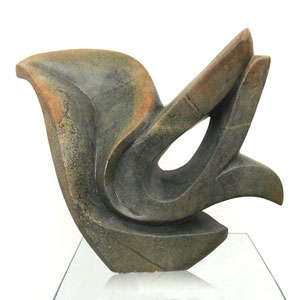Protect sculptors from piracy

be said about the visual arts.
This article is written in response to various complaints from Zimbabwean sculptors about their stone works being copied, redesigned or reproduced from photographs by some foreign buyers citing, Chinese, Belgian,
Dutch, English and American collectors (names supplied).
These works are subsequently sold as “original” at unrealistically low prices, which has been the major cause of the demise of this cultural commodity. In light of the above, this writer will delve into the murky waters of the history of fakes and forgeries in art and how this scourge can and should be curbed in Zimbabwe, which this writer has heard described as the “El Dorado of Stone Sculpture”.
What is a fake work of art?
The word “fake” is defined as “an article of artistic value made, copied or in some way altered with the deliberate intention of deception, so as to increase its value”.
Sir John Pipers’ definition is expanded to read: “a fake is a work of art fraudulently sculpted or painted and passed off and sold as the work of a generally more collectable artist”.
The key words here, being “collectable artist”. He elaborates that “one must note that forgeries and fakes are not necessarily the same as a work of a painter or sculptor painting or sculpting in the manner of a great master artist”.
As indeed for many centuries such practices (i.e. apprenticeships) were regarded as an essential part of the artist’s training. The apprenticeship scholar/master system still exists amongst many craftsmen and artists in Zimbabwe and other parts of Africa, Europe, Asia and the Americas today. It is regarded as the most effective “hands on” tutorship.
The practice of faking works of art for an eager and gullible market has been going on since European Classical times. However, by the late 20th century, the physical properties of suspected fakes could now be examined using various scientific methods, including X-rays and chemicals analysis, but such material tests have not always been foolproof given the development of modern cleaning agents which may alter the chemical composition of the material, additionally, numerous finger prints may be imprinted whilst transporting the works of art, which may confuse the DNA sweat tests making a provenance record more elusive then ever.
In recent technological advances, forgers have acquired extraordinary levels of sophistication, not only in their at tempts to mimic the styles of famous artists of past and present, but also in their abilities to use or imitate their materials and techniques and even the effects of aging such as “craquelure” in oil paintings and eluding carbon dating and DNA sweat tests in African wooden antiquities. This is now a field of common speculation for scholars and specialise in art history and archeological artifacts.
The process and techniques of science have no Seeing Eye. In practically every case of forgery uncovered, it has been the aesthetically trained eye and educated enquiring mind, which has detected the forgery and started the chase. Art forgers often rush in to satisfy a demand or vogue for a particular period or category of objects, or artists’ work being sought after by collectors or buyers. Part of the answer with any great works of art is that it has come into being at the height of the master artist’s powers, when the act for creating has gone beyond the strictures of technique and the master works with a full-blooded freedom that pulsates with life and achievement – a creative euphoria and psychological human feeling which is difficult to fake.
Cruel punishment for copy cats “chitokisi”
In 1562, in England, the crime for forging an artist’s work was punishable in lower degrees by a hefty fine and at the other end of the scale, by being pilloried, whilst the offender’s head, hands and feet were bound in stocks, “chitokisi” not unlike the Shona traditional “Mbira DzaKondo”. The perpetrator was publicly stoned or pelted, until near death, with rotten foods, vegetables, feaces, hot tar or pig manure, by the public, both ears cut off, the nostrils slit up and seared in the publics’ presence. Forfeiture of land and perpetual imprisonment if he survived the physical punishment.
This state of affairs continued well into the 18th century and led to Hogarth’s Copyright Act of 1735, which gave 14 years protection from copying, followed by amendments in 1761, 1777 and 1836. It concerns the right to control, literally, theatrical, musical or artistic works for a determined number of years. Subsequently, the term “intellectual property” came into use as a term for patents, copyright and other laws in the 19th century. This idea of the artist as an original creator and owner of their work was made popular by John Locke’s theory that artists invested labour into natural goods and so created property. Copyright owners have the exclusive statutory right to exercise control over copying and other exploitation of their work.
Today, however, copyright laws have been standardised to some extent, through international and regional agreements such as the Berne Convention (1886), and the European Copyright Directives, giving each jurisdiction distinct laws and regulations on copyright, which may vary between countries.
Lenient punishment today;
Today, unfortunately, the punishment is lenient and not commensurate with the crime committed by the forger. For example, a notorious art forger Han van Meergeren, who was one of two of the most famous European forgers of the last century, totted up a total of over US$30 million, he owned 52 houses and 15 country houses around Laven in Holland, from his copies of Vermeer’s paintings.
Jan Vermeer (1632- 1675) was a Dutch artist and picture dealer with a marvelous extraordinary realistic technique of painting. His work “A View of Delft” housed in The Hauge Mauritshuis is reputed to be one of the most remarkable landscapes in the world history of art. Han van Meergeren received a jail sentence of just one-year for his offences – on the 29th May 1945 presumable, owing to the war (World War II), he was released in February 1946. He was retried in 1947, and died of a heart attack soon after.
His accumulated forgeries were equivalent to US$47 million, and he is known as one of the greatest art forgers in history.
The other, Tom Keating, (1917-1984) an Englishman, successfully painted in the style of a large number of modern European masters. He is reported to have forged over 2 000 paintings of approximately 100 modern artists.
He starred in a television programme after confessing in 1976, of his crimes. He boastfully claimed that the galleries of the world were full of his fraudulent reproductions, whose directors and curators are too embarrassed to admit owning or exhibiting a forgery.
Ironically today, Keating is an historical case study, whose works are analysed and studied by those undertaking courses in world art auctioneering and criminal detection of fakes.
In an interesting twist of fate, a UK artist, John Myatt (1945) created works attributed to several modern artists, amongst them Chagall, Giacometti, Picasso and Renoir and Nicholson. He was imprisoned for his crimes, and released in 2000, after which he started creating his own art, which now sell at notoriously high prices due to his infamy.
Historic cases of art fakes in Zimbabwe
The illegal reproduction of fake stone sculptures of Zimbabwean origin has become more pronounced in recent decades and is most widespread in China, Belgium, Holland, UK and the USA. But the source of production is largely Zimbabwean, where the art and artist is not appreciated and the works undervalued.
The destinations of the fake sculptures are difficult to trace and only come to light when serious Euro-American buyers come to Zimbabwe and realise that they have probably bought a “fake” overseas. Once again the lack of effective legal instruments and structured forums for dialogue and arbitration render the art trade open to counterfeit fakes and mass reproduction of our cultural heritage. For example, as early as in 1978, fake sculptures attributed to the late Henry Munyaradzi first came to light in South Africa and California, USA, and were also found in 1986 in the UK.
By the mid-1990s, more fake stone sculptures were discovered in Zurich, Switzerland, Paris, France and Brussels, Belgium. These were works by other Zimbabwean stone master artists, namely, Ephraim Chaurika’s “African Spirit Horses” series @ 1982. Brighton Sango’s cubist inspired “Mother and Child” series, @ 1986, “Mother Care” series @ 1989 and “Magic Flower” series @ 1991. Fanizani Akuda’s “Funny Girl” series @ 1986, and “Man Inside Wings of a Bird” @ 1986. As well as Joseph Ndandarika’s “Friend of the Animal ” @ 1986, and his “Thinking Man” series 1989, and finally, Albert Mamvura’s abstract lyrical stone sculptures, @1996.
Breaking the fakes
Locally, Lazarus Takawira had said during a BBC Channel 4 interview: “If anyone copies my work, I take a (14 pound) hammer and smash the sculpture to pieces.” Although one could not agree more, this action has not deterred the proliferation of fakes. The punishment for forgers and fakes is very lenient in this country, due to the lack appreciation for art and the gravity of the offence of art forgeries. Faking a work of art constitutes:
(a) Depriving the artist of income,
(b) Theft of intellectual property,
(c) Forgery by deceiving the buyer with “stolen” goods
(d) Flouting copyright law.
These are some of the compounded offences committed when a forger copies a work of art – regardless the medium. Due to the lack of seriousness and interest by the lawmakers of Zimbabwe, on the subject, many artists have fallen victim to art forgers.
Benhura’s trial;
What is regrettable is that none of these pioneer Zimbabwean artists were compensated for their loss of income, nor were they legally empowered to stop the forgery racket due to their lack of knowledge of legal arbitration. Rather than stop the forgery racket, they often unknowingly sold more of their works to the same corrupt art dealers.
An historical on June 2007, Case HC28/04
Following the huge global success of his animated figures in motion, an entire consignment of 45 forged works attributed to him and estimated to fetch over US$170 000 on the art market today was unearthed by Benhura.
He took legal action and won the case, but was unfairly awarded a pittance of Z$400 compensation for his “intellectual property” and a lifetime artistic endeavour.
By all accounts, the artist should have been compensated real time value of the works that were forged and the perpetrator jailed by the value of the faked goods.
Benhura did not receive justice, and he is not alone. In a similar case, this writer was reliably informed of 23 copies of his own sculptures at Avondale flea market in 2005, and for the past five years has been trying to trace the perpetrator in vain. The works are believed to have sold out.
Although the Unesco Convention (1970) “Convention on the means of prohibiting and preventing the illicit import/export and transfer of ownership of cultural property” exists it does not cover the fake and disposal of contemporary Zimbabwean visual arts.
Today, the deceptively and usually shortlived but highly profitable, practice of art forgery has not ceased. In fact, recent reports cite African art, both antique and modern, as the biggest target for the reproduction and fakes the world over.
China is today the most notorious for creating reproductions of unsigned Zimbabwean Shona sculpture in order to evade legal reprisal. The works are simply labelled “Made in Zimbabwe” and sold as cheap “curios” to unsuspecting buyers. How do we bring them to book? They have turned the works of our great Zimbabwean contemporary stone masters into “Made in China” curios.
In conclusion, in light of the above, the Zimbabwean judiciary should immediately develop legal instruments, that not only prevent the haemorrhaging and the destruction of our heritage, but also enhance the capacity to safeguard our heritage and the purveyors of the visual arts – our beloved stone sculptors on the international markets.











Comments